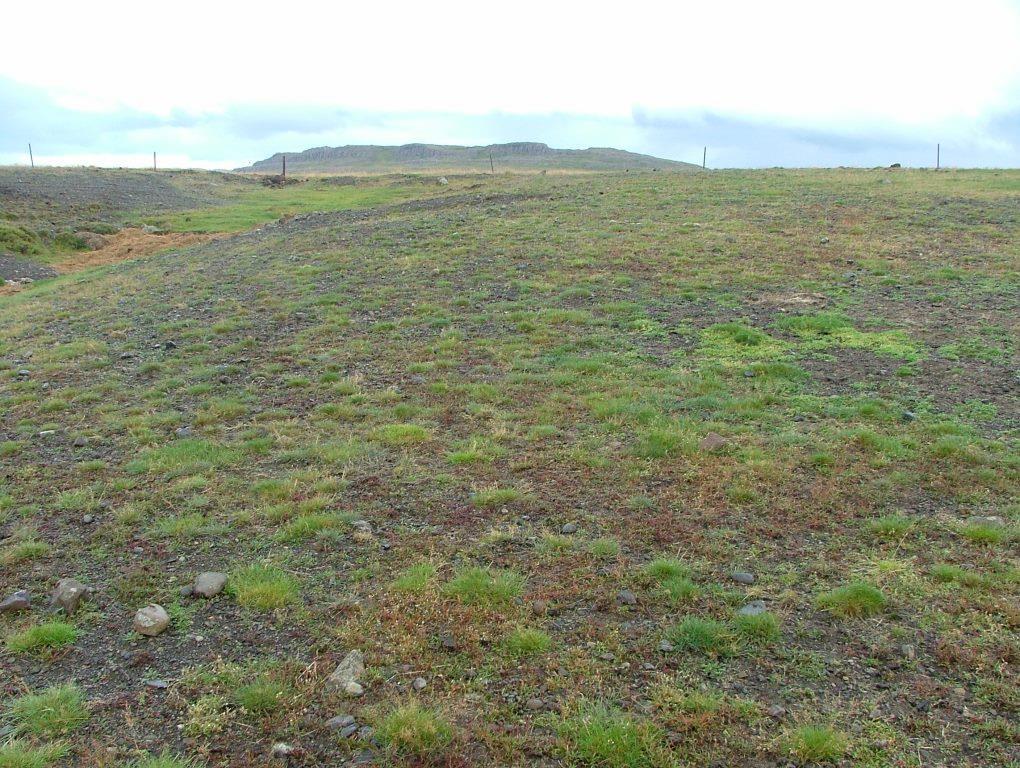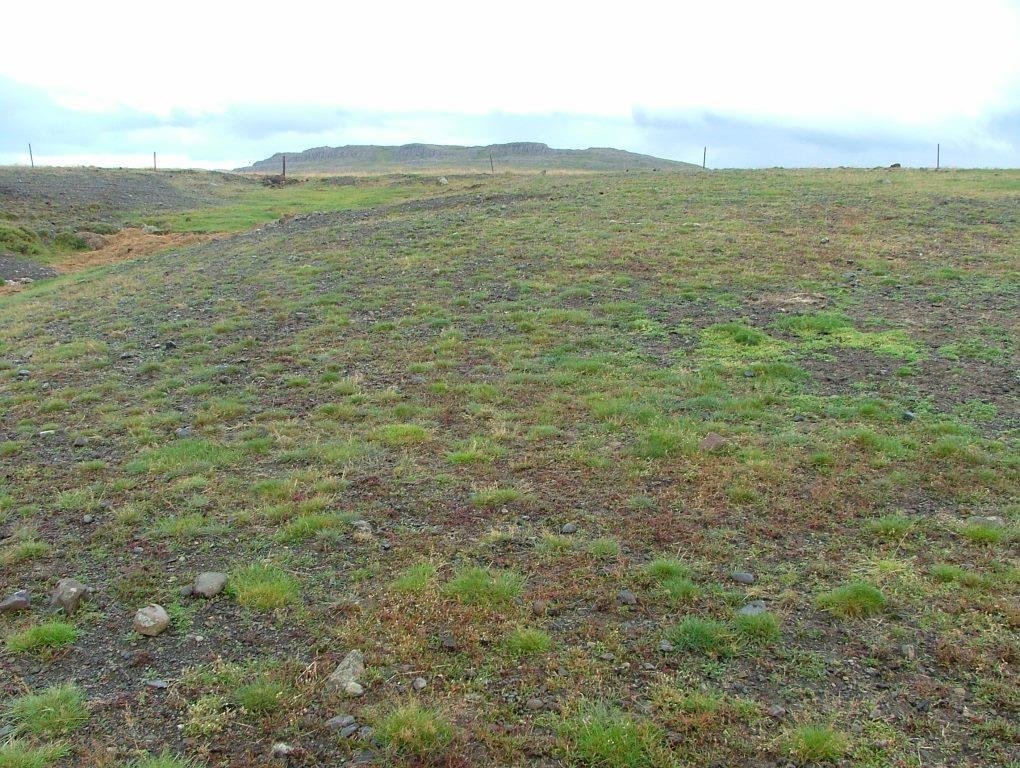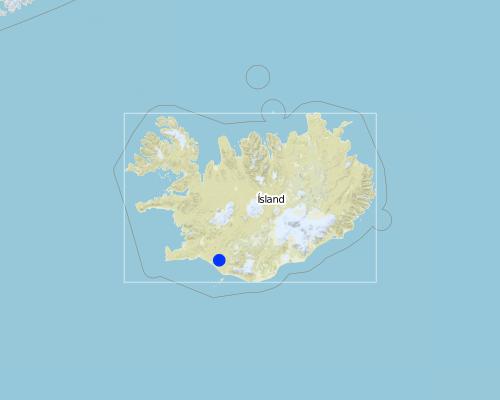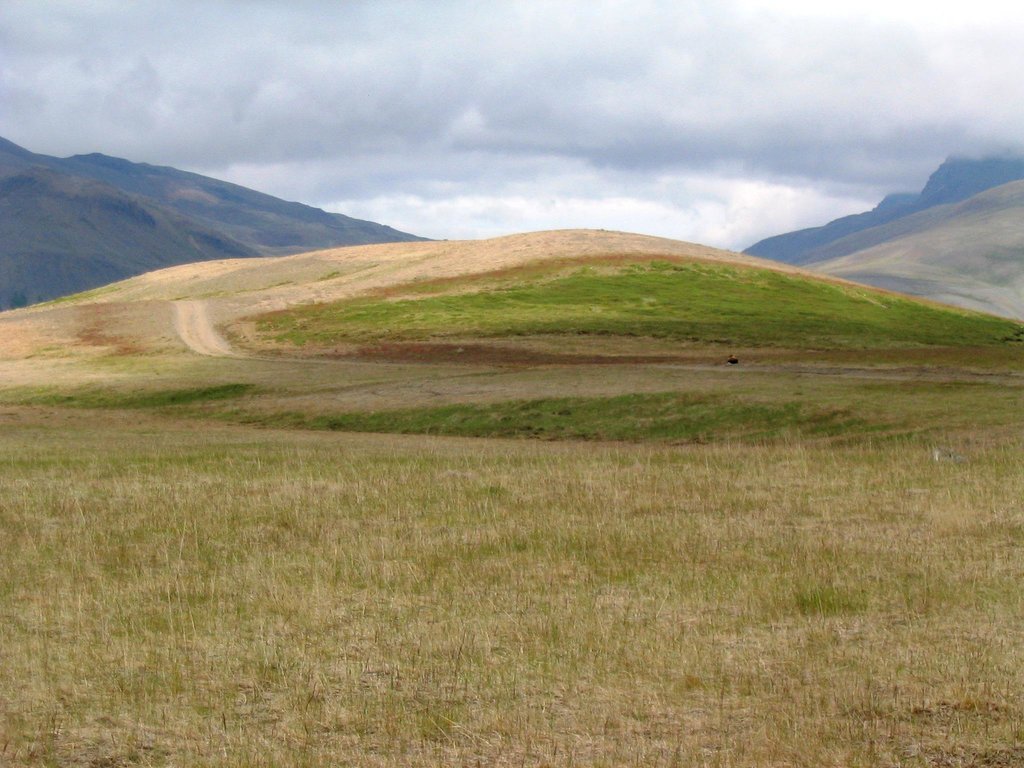Fertilizing and re-seeding degraded rangelands [Islande]
- Création :
- Mise à jour :
- Compilateur : Thorunn Petursdottir
- Rédacteur : –
- Examinateur : Fabian Ottiger
Hekluskogar area
technologies_1261 - Islande
Voir les sections
Développer tout Réduire tout1. Informations générales
1.2 Coordonnées des personnes-ressources et des institutions impliquées dans l'évaluation et la documentation de la Technologie
Nom du projet qui a facilité la documentation/ l'évaluation de la Technologie (si pertinent)
Preventing and Remediating degradation of soils in Europe through Land Care (EU-RECARE )Nom du ou des institutions qui ont facilité la documentation/ l'évaluation de la Technologie (si pertinent)
Soil Conservation Service of Iceland (Soil Conservation Service of Iceland) - Islande1.3 Conditions relatives à l'utilisation par WOCAT des données documentées
Quand les données ont-elles été compilées (sur le terrain)?
08/05/2015
Le compilateur et la(les) personne(s) ressource(s) acceptent les conditions relatives à l'utilisation par WOCAT des données documentées:
Oui
2. Description de la Technologie de GDT
2.1 Courte description de la Technologie
Définition de la Technologie:
Rangeland restoration - Spreading small portions of inorganic fertilizer and seeds on degraded rangelands
2.2 Description détaillée de la Technologie
Description:
The concerning rangelands are severely degraded and parts of them have even lost their topsoil layer entirely. Nevertheless, in many cases some remnant vegetation patches are still in place and can serve as seed banks during the restoration process. In order to stabilize the surface (i.e. to reduce the effects of freeze-thaw processes), provide nutrients to the system, increase water availability and facilitate the distribution of native species within the degraded areas, tractors are used to fertilize and reseed the areas with grass species that later in the process will retreat as soon as the dispersal of native species increases. All implementations are based on the methods and tools used in ecological restoration, aiming at re-activating environmental and ecological processes and increasing the resilience of the ecosystems undergoing restoration. Minimum portions of fertilizer and seed are distributed over pre-selected areas, preferably close to the remaining vegetation "islands" in order to facilitate seed production and dispersal and provide safe sites for seed germination.
Purpose of the Technology: The purpose with the technology is to halt further land degradation and facilitate natural succession within the area undergoing restoration. In the long-term, it should substantially reduce wind and water erosion. It should also lead to increased biodiversity, enhanced water availability and accelerated carbon sequestration (in soil and vegetation). The overall restoration task is to increase the resilience of the ecosystems against natural hazards; such as volcanic activities.
Establishment / maintenance activities and inputs: In the first year, the areas are treated with a mixture of chemical fertilizer that fits the local soil condition and grass seed that are proofed to survive under harsh condition. A mixture of approx 200 kg/ha of fertilizer and around 10 kg/ha of grass seed (usually a mixture of Poa and Festuca species) is spread over the treated area. The year after the area is treated again, this time with fertilizer only (approx 100-150 kg/ha). Then the area is usually treated biannually for 4 to 6 years, based on the vegetational succession rate.
Natural / human environment: In the long-term, the technology is expected to substantially increase biomass production, re-build soil qualities, accelerate carbon sequestration and secure water availability within the rangeland and the adjacent ecosystems. The areas still grazed are expected to be more suitable for livestock grazing and the protected areas are expected to be of more recreational and aesthetic value. Increased vegetation cover will reduce and even halt the sand drift that still creates challenges for inhabitants in adjacent villages, on farmsteads and within the summerhouse clusters, scattered around the area. As the degraded rangeland is in the vicinity of an active volcano (Mt Hekla) the technology is also expected to increase ecosystem resilience against natural hazards like ash and pumice drift and reduce potential offsite damages caused by these materials.
2.3 Photos de la Technologie
2.5 Pays/ région/ lieux où la Technologie a été appliquée et qui sont couverts par cette évaluation
Pays:
Islande
Région/ Etat/ Province:
Rangarthing Ytra
Autres spécifications du lieu:
Rangarvellir
Map
×2.6 Date de mise en œuvre de la Technologie
Si l'année précise est inconnue, indiquez la date approximative: :
- il y a plus de 50 ans (technologie traditionnelle)
2.7 Introduction de la Technologie
Spécifiez comment la Technologie a été introduite: :
- dans le cadre d'un système traditionnel (> 50 ans)
- par le biais de projets/ d'interventions extérieures
- by the Soil Conservation Service (governmental institute)
3. Classification de la Technologie de GDT
3.2 Type(s) actuel(s) d'utilisation des terres, là où la Technologie est appliquée

Pâturages
Pâturage extensif:
- Semi-nomadisme/ pastoralisme
Principales espèces animales et principaux produits:
Main species: Sheep

Forêts/ bois
Produits et services:
- Pâturage/ broutage
- Conservation/ protection de la nature
- Loisirs/ tourisme
- Protection contre les aléas naturels
Commentaires:
Major land use problems (compiler’s opinion): Vast parts of the area are heavily degraded due to unsustainable land use through the centuries in combination to harsh climate and frequent volcanic eruptions. The major land use problem are related to the fact that the concerned ecosystems collapsed long time ago and despite all restoration efforts implemented within the area for over 100 years, the systems are still highly dysfunctional. Their carrying capacity is limited and even light livestock grazing can keep further vegetational succession down. Passive restoration might take place where the livestock grazing has been excluded but in most cases some technologies are needed to "kickstart" the ecosystem and brake their negative resilience against changes.
Major land use problems (land users’ perception): They are fully aware that the ecosystems are in a poor condition and restoration is needed in order to push improvements forward. They acknowledge that grazing of collapsed ecosystems can maintain the dysfunctional of the systems and hinder ecological improvements. Nevertheless, in many cases they believe the harsh climate and volcanic activities are the main contributors to land degradation - that livestock grazing and the grazing carrying capacity of the rangeland are not fundamental issues in this context.
Types of other land: Wastelands / deserts / glaciers / swamps
Types of other land: Recreation
Si l'utilisation des terres a changé en raison de la mise en œuvre de la Technologie, indiquez l'utilisation des terres avant la mise en œuvre de la Technologie:
Grazing land: Ge: Extensive grazing land
3.3 Informations complémentaires sur l'utilisation des terres
Nombre de période de croissance par an: :
- 1
3.4 Groupe de GDT auquel appartient la Technologie
- Amélioration de la couverture végétale/ du sol
3.5 Diffusion de la Technologie
Commentaires:
Total area covered by the SLM Technology is 900 m2.
3.6 Mesures de GDT constituant la Technologie

pratiques végétales
- V2: Herbes et plantes herbacées pérennes

structures physiques
- S11: Autres

modes de gestion
- M2: Changement du niveau de gestion / d'intensification
Commentaires:
Main measures: vegetative measures, management measures
Specification of other structural measures: fertilizing and seeding rather flat but gravel surface
Type of agronomic measures: retaining more vegetation cover, mineral (inorganic) fertilizers
Type of vegetative measures: scattered / dispersed
3.7 Principaux types de dégradation des terres traités par la Technologie

érosion hydrique des sols
- Wt: perte de la couche superficielle des sols (couche arable)/ érosion de surface
- Wo: effets hors-site de la dégradation

érosion éolienne des sols
- Et: perte de la couche superficielle des sols (couche arable)

dégradation biologique
- Bc: réduction de la couverture végétale

dégradation hydrique
- Hg: changement du niveau des nappes phréatiques (eaux souterraines) et des aquifères
Commentaires:
Main type of degradation addressed: Wt: loss of topsoil / surface erosion, Et: loss of topsoil, Bc: reduction of vegetation cover
Secondary types of degradation addressed: Wo: offsite degradation effects, Hg: change in groundwater / aquifer level
Main causes of degradation: deforestation / removal of natural vegetation (incl. forest fires) (in earlier centuries), over-exploitation of vegetation for domestic use (in earlier centuries), overgrazing (in earlier centuries), change in temperature, wind storms / dust storms, other natural causes (avalanches, volcanic eruptions, mud flows, highly susceptible natural resources, extreme topography, etc.) specify, poverty / wealth (in earlier centuries)
Secondary causes of degradation: soil management (in earlier centuries (from settlement in 874 onward)), floods, droughts, land tenure, governance / institutional (vague policies (especially in the last 50 years or so))
3.8 Prévention, réduction de la dégradation ou réhabilitation des terres dégradées
Commentaires:
Main goals: prevention of land degradation, mitigation / reduction of land degradation, rehabilitation / reclamation of denuded land
4. Spécifications techniques, activités, intrants et coûts de mise en œuvre
4.1 Dessin technique de la Technologie
4.2 Spécification/ explications techniques du dessin technique
Technical knowledge required for field staff / advisors: moderate
Technical knowledge required for land users: moderate
Main technical functions: control of raindrop splash, control of dispersed runoff: retain / trap, control of dispersed runoff: impede / retard, control of concentrated runoff: retain / trap, control of concentrated runoff: impede / retard, control of concentrated runoff: drain / divert, improvement of ground cover, increase of surface roughness, improvement of surface structure (crusting, sealing), improvement of topsoil structure (compaction), stabilisation of soil (eg by tree roots against land slides), increase in organic matter, increase in nutrient availability (supply, recycling,…), increase of infiltration, increase / maintain water stored in soil, increase of groundwater level / recharge of groundwater, improvement of water quality, buffering / filtering water, sediment retention / trapping, sediment harvesting, increase of biomass (quantity), promotion of vegetation species and varieties (quality, eg palatable fodder)
Secondary technical functions: reduction of slope angle, reduction of slope length, improvement of subsoil structure (hardpan), water harvesting / increase water supply, reduction in wind speed, spatial arrangement and diversification of land use
Retaining more vegetation cover
Material/ species: grass seed (mixture of seed)
Quantity/ density: 10 kg/ha
Mineral (inorganic) fertilizers
Quantity/ density: 200 kg/ha
Scattered / dispersed
Vegetative material: G : grass
Trees/ shrubs species: Birch and some native willow species are expected to follow up as natural regeneration (secondary succession)
Change of land use type: Part of the areas was fenced off and is now protected from grazing
Change of land use practices / intensity level: During the last decades, the summer grazing period has been shortened substantially
4.3 Informations générales sur le calcul des intrants et des coûts
autre/ monnaie nationale (précisez):
ISK
Indiquer le taux de change du dollars en monnaie locale (si pertinent): 1 USD= :
113,0
4.4 Activités de mise en place/ d'établissement
| Activité | Type de mesures | Calendrier | |
|---|---|---|---|
| 1. | Fertilizing and re-seeding | Modes de gestion | May/June |
4.5 Coûts et intrants nécessaires à la mise en place
| Spécifiez les intrants | Unité | Quantité | Coûts par unité | Coût total par intrant | % des coût supporté par les exploitants des terres | |
|---|---|---|---|---|---|---|
| Main d'œuvre | Fertilizing and re-seeding | ha | 1,0 | 66,0 | 66,0 | |
| Equipements | Machine use | ha | 1,0 | 44,0 | 44,0 | 100,0 |
| Matériel végétal | Seeds (20kg) | ha | 1,0 | 137,0 | 137,0 | |
| Engrais et biocides | Fertilizer (200kg) | ha | 1,0 | 118,0 | 118,0 | |
| Coût total de mise en place de la Technologie | 365,0 | |||||
4.7 Coûts et intrants nécessaires aux activités d'entretien/ récurrentes (par an)
| Spécifiez les intrants | Unité | Quantité | Coûts par unité | Coût total par intrant | % des coût supporté par les exploitants des terres | |
|---|---|---|---|---|---|---|
| Main d'œuvre | Labour | ha | 1,0 | 66,0 | 66,0 | |
| Equipements | Machine use | ha | 1,0 | 44,0 | 44,0 | 100,0 |
| Engrais et biocides | fertilizer | ha | 1,0 | 118,0 | 118,0 | |
| Coût total d'entretien de la Technologie | 228,0 | |||||
Commentaires:
The cost was estimated based on official estimation numbers from the SCSI
5. Environnement naturel et humain
5.1 Climat
Précipitations annuelles
- < 250 mm
- 251-500 mm
- 501-750 mm
- 751-1000 mm
- 1001-1500 mm
- 1501-2000 mm
- 2001-3000 mm
- 3001-4000 mm
- > 4000 mm
Zone agro-climatique
- subhumide
- semi-aride
Thermal climate class: boreal
Thermal climate class: polar/arctic
5.2 Topographie
Pentes moyennes:
- plat (0-2 %)
- faible (3-5%)
- modéré (6-10%)
- onduleux (11-15%)
- vallonné (16-30%)
- raide (31-60%)
- très raide (>60%)
Reliefs:
- plateaux/ plaines
- crêtes
- flancs/ pentes de montagne
- flancs/ pentes de colline
- piémonts/ glacis (bas de pente)
- fonds de vallée/bas-fonds
Zones altitudinales:
- 0-100 m
- 101-500 m
- 501-1000 m
- 1001-1500 m
- 1501-2000 m
- 2001-2500 m
- 2501-3000 m
- 3001-4000 m
- > 4000 m
5.3 Sols
Profondeur moyenne du sol:
- très superficiel (0-20 cm)
- superficiel (21-50 cm)
- modérément profond (51-80 cm)
- profond (81-120 cm)
- très profond (>120 cm)
Texture du sol (de la couche arable):
- grossier/ léger (sablonneux)
Matière organique de la couche arable:
- faible (<1%)
Si disponible, joignez une description complète du sol ou précisez les informations disponibles, par ex., type de sol, pH/ acidité du sol, capacité d'échange cationique, azote, salinité, etc.
Soil fertility is very low- low
Soil water storage capacity is very low-low
5.4 Disponibilité et qualité de l'eau
Disponibilité de l’eau de surface:
faible/ absente
Qualité de l’eau (non traitée):
eau potable
5.5 Biodiversité
Diversité des espèces:
- faible
5.6 Caractéristiques des exploitants des terres appliquant la Technologie
Orientation du système de production:
- subsistance (auto-approvisionnement)
Individus ou groupes:
- individu/ ménage
Genre:
- femmes
- hommes
Indiquez toute autre caractéristique pertinente des exploitants des terres:
Land users applying the Technology are mainly common / average land users
Population density: < 10 persons/km2
5.7 Superficie moyenne des terres détenues ou louées par les exploitants appliquant la Technologie
- < 0,5 ha
- 0,5-1 ha
- 1-2 ha
- 2-5 ha
- 5-15 ha
- 15-50 ha
- 50-100 ha
- 100-500 ha
- 500-1 000 ha
- 1 000-10 000 ha
- > 10 000 ha
Cette superficie est-elle considérée comme de petite, moyenne ou grande dimension (en se référant au contexte local)?
- moyenne dimension
5.8 Propriété foncière, droits d’utilisation des terres et de l'eau
- governmental institutes
5.9 Accès aux services et aux infrastructures
santé:
- pauvre
- modéré
- bonne
éducation:
- pauvre
- modéré
- bonne
assistance technique:
- pauvre
- modéré
- bonne
emploi (par ex. hors exploitation):
- pauvre
- modéré
- bonne
marchés:
- pauvre
- modéré
- bonne
énergie:
- pauvre
- modéré
- bonne
routes et transports:
- pauvre
- modéré
- bonne
eau potable et assainissement:
- pauvre
- modéré
- bonne
services financiers:
- pauvre
- modéré
- bonne
6. Impacts et conclusions
6.1 Impacts sur site que la Technologie a montrés
Impacts socio-économiques
Production
production animale
Disponibilité et qualité de l'eau
disponibilité de l'eau pour l'élevage
qualité de l'eau pour l'élevage
Impacts socioculturels
sécurité alimentaire/ autosuffisance
opportunités culturelles
possibilités de loisirs
institutions communautaires
institutions nationales
connaissances sur la GDT/ dégradation des terres
apaisement des conflits
situation des groupes socialement et économiquement désavantagés
Impacts écologiques
Cycle de l'eau/ ruissellement
quantité d'eau
qualité de l'eau
ruissellement de surface
drainage de l'excès d'eau
nappes phréatiques/ aquifères
évaporation
Sols
humidité du sol
couverture du sol
perte en sol
encroûtement/ battance du sol
cycle/ recharge des éléments nutritifs
matière organique du sol/ au dessous du sol C
Biodiversité: végétale, animale
biomasse/ au dessus du sol C
diversité végétale
diversité animale
diversité des habitats
Réduction des risques de catastrophe et des risques climatiques
émissions de carbone et de gaz à effet de serre
vitesse du vent
6.2 Impacts hors site que la Technologie a montrés
disponibilité de l'eau
inondations en aval
envasement en aval
capacité tampon/de filtration
sédiments (indésirables) transportés par le vent
dommages sur les champs voisins
dommages sur les infrastructures publiques/ privées
6.3 Exposition et sensibilité de la Technologie aux changements progressifs et aux évènements extrêmes/catastrophes liés au climat (telles que perçues par les exploitants des terres)
Changements climatiques progressifs
Changements climatiques progressifs
| Saison | Type de changements/ extrêmes climatiques | Comment la Technologie fait-elle face à cela? | |
|---|---|---|---|
| températures annuelles | augmente | pas connu |
Extrêmes climatiques (catastrophes)
Catastrophes météorologiques
| Comment la Technologie fait-elle face à cela? | |
|---|---|
| pluie torrentielle locale | bien |
| tempête de vent locale | bien |
Catastrophes climatiques
| Comment la Technologie fait-elle face à cela? | |
|---|---|
| sécheresse | pas bien |
Catastrophes hydrologiques
| Comment la Technologie fait-elle face à cela? | |
|---|---|
| inondation générale (rivière) | bien |
Autres conséquences liées au climat
Autres conséquences liées au climat
| Comment la Technologie fait-elle face à cela? | |
|---|---|
| réduction de la période de croissance | pas connu |
| Cold spells combined with wind storms | pas bien |
6.4 Analyse coûts-bénéfices
Quels sont les bénéfices comparativement aux coûts de mise en place (du point de vue des exploitants des terres)?
Rentabilité à court terme:
légèrement positive
Rentabilité à long terme:
positive
Quels sont les bénéfices comparativement aux coûts d'entretien récurrents (du point de vue des exploitants des terres)?
Rentabilité à court terme:
légèrement positive
Rentabilité à long terme:
positive
6.5 Adoption de la Technologie
Commentaires:
There is a moderate trend towards spontaneous adoption of the Technology
6.7 Points forts/ avantages/ possibilités de la Technologie
| Points forts/ avantages/ possibilités du point de vue du compilateur ou d'une autre personne ressource clé |
|---|
| It bases on the ecosystem approach - working with nature and re-establishing dysfunctional environmental and ecological processes with strong stakeholder involvement |
Liens et modules
Développer tout Réduire toutLiens
Aucun lien
Modules
Aucun module trouvé





